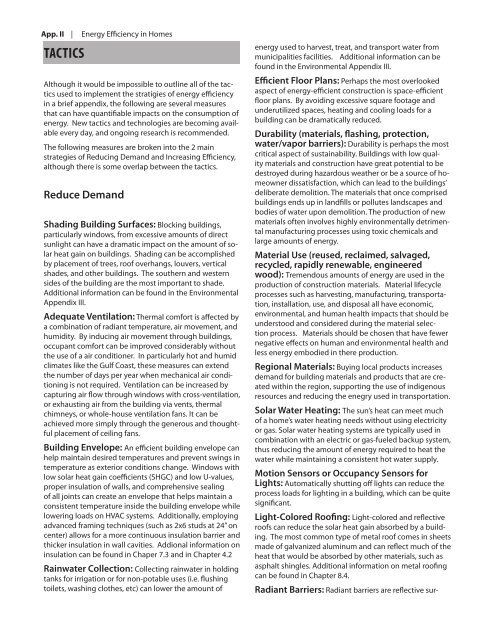Alternative Construction Research Guide - GCCDS
Alternative Construction Research Guide - GCCDS
Alternative Construction Research Guide - GCCDS
You also want an ePaper? Increase the reach of your titles
YUMPU automatically turns print PDFs into web optimized ePapers that Google loves.
App. II | Energy Efficiency in HomesTACTICSAlthough it would be impossible to outline all of the tacticsused to implement the stratigies of energy efficiencyin a brief appendix, the following are several measuresthat can have quantifiable impacts on the consumption ofenergy. New tactics and technologies are becoming availableevery day, and ongoing research is recommended.The following measures are broken into the 2 mainstrategies of Reducing Demand and Increasing Efficiency,although there is some overlap between the tactics.Reduce DemandShading Building Surfaces: Blocking buildings,particularly windows, from excessive amounts of directsunlight can have a dramatic impact on the amount of solarheat gain on buildings. Shading can be accomplishedby placement of trees, roof overhangs, louvers, verticalshades, and other buildings. The southern and westernsides of the building are the most important to shade.Additional information can be found in the EnvironmentalAppendix III.Adequate Ventilation: Thermal comfort is affected bya combination of radiant temperature, air movement, andhumidity. By inducing air movement through buildings,occupant comfort can be improved considerably withoutthe use of a air conditioner. In particularly hot and humidclimates like the Gulf Coast, these measures can extendthe number of days per year when mechanical air conditioningis not required. Ventilation can be increased bycapturing air flow through windows with cross-ventilation,or exhausting air from the building via vents, thermalchimneys, or whole-house ventilation fans. It can beachieved more simply through the generous and thoughtfulplacement of ceiling fans.Building Envelope: An efficient building envelope canhelp maintain desired temperatures and prevent swings intemperature as exterior conditions change. Windows withlow solar heat gain coefficients (SHGC) and low U-values,proper insulation of walls, and comprehensive sealingof all joints can create an envelope that helps maintain aconsistent temperature inside the building envelope whilelowering loads on HVAC systems. Additionally, employingadvanced framing techniques (such as 2x6 studs at 24” oncenter) allows for a more continuous insulation barrier andthicker insulation in wall cavities. Addional information oninsulation can be found in Chaper 7.3 and in Chapter 4.2Rainwater Collection: Collecting rainwater in holdingtanks for irrigation or for non-potable uses (i.e. flushingtoilets, washing clothes, etc) can lower the amount ofenergy used to harvest, treat, and transport water frommunicipalities facilities. Additional information can befound in the Environmental Appendix III.Efficient Floor Plans: Perhaps the most overlookedaspect of energy-efficient construction is space-efficientfloor plans. By avoiding excessive square footage andunderutilized spaces, heating and cooling loads for abuilding can be dramatically reduced.Durability (materials, flashing, protection,water/vapor barriers): Durability is perhaps the mostcritical aspect of sustainability. Buildings with low qualitymaterials and construction have great potential to bedestroyed during hazardous weather or be a source of homeownerdissatisfaction, which can lead to the buildings’deliberate demolition. The materials that once comprisedbuildings ends up in landfills or pollutes landscapes andbodies of water upon demolition. The production of newmaterials often involves highly environmentally detrimentalmanufacturing processes using toxic chemicals andlarge amounts of energy.Material Use (reused, reclaimed, salvaged,recycled, rapidly renewable, engineeredwood): Tremendous amounts of energy are used in theproduction of construction materials. Material lifecycleprocesses such as harvesting, manufacturing, transportation,installation, use, and disposal all have economic,environmental, and human health impacts that should beunderstood and considered during the material selectionprocess. Materials should be chosen that have fewernegative effects on human and environmental health andless energy embodied in there production.Regional Materials: Buying local products increasesdemand for building materials and products that are createdwithin the region, supporting the use of indigenousresources and reducing the enegry used in transportation.Solar Water Heating: The sun’s heat can meet muchof a home’s water heating needs without using electricityor gas. Solar water heating systems are typically used incombination with an electric or gas-fueled backup system,thus reducing the amount of energy required to heat thewater while maintaining a consistent hot water supply.Motion Sensors or Occupancy Sensors forLights: Automatically shutting off lights can reduce theprocess loads for lighting in a building, which can be quitesignificant.Light-Colored Roofing: Light-colored and reflectiveroofs can reduce the solar heat gain absorbed by a building.The most common type of metal roof comes in sheetsmade of galvanized aluminum and can reflect much of theheat that would be absorbed by other materials, such asasphalt shingles. Additional information on metal roofingcan be found in Chapter 8.4.Radiant Barriers: Radiant barriers are reflective sur-
















